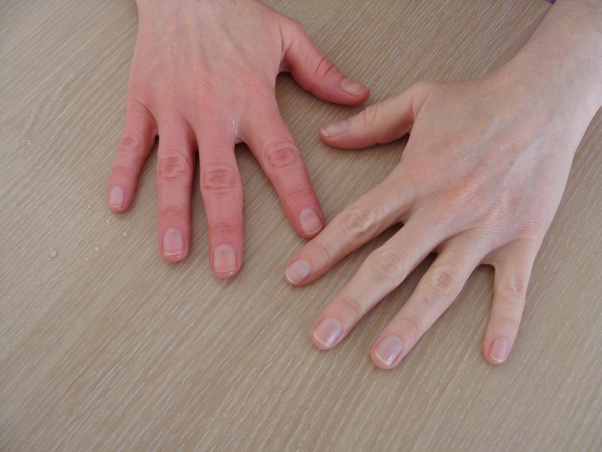Does liver disease cause red palms? Palmar erythema is a symptom of many different conditions. Its appearance is often the first sign of an underlying medical concern. For example, palmar erythema is associated with several forms of liver disease. About 23 percent of people who have cirrhosis of the liver also experience palmar erythema.
First, What are Covid fingers? COVID toes can also begin with a purplish color. Symptoms: Many people don’t feel anything and only realize that they have COVID toes when they see the discoloration and swelling on their feet (or hands). Along with the swelling and discoloration, COVID toes can also cause blisters, itch, or pain.
Does fatty liver cause red hands? Symptoms of Fatty Liver Disease
Swollen belly. Enlarged blood vessels underneath your skin. Larger-than-normal breasts in men. Red palms.
Second, Are red Palms serious? On its own, palmar erythema is benign, meaning it is not harmful to you. However, if you are experiencing palmar erythema as the result of an underlying condition, then you may notice changes in your palms as the underlying medical condition is treated.
What do red hands look like with liver damage?
What is COVID tongue?
The first mention of COVID tongue came in 2021 when a British professor of genetic epidemiology tweeted about tongue changes – mainly inflammation – and an increased presence of mouth ulcers among COVID patients.
Does COVID affect your hands?
Skin changes.
Swelling or discoloration can develop on one or several toes or fingers. The hands, wrists or ankles also can be affected. Blisters, itchiness, rough skin, or painful bumps can occur.
Why are my fingertips red and swollen?
Swollen fingers refers to the enlargement of an individual’s fingers as a result of an underlying physical cause. Potential causes include arthritis, exercise, high salt levels, allergic reactions, medication side effects, and injury.
Why are my hands so red and dry?
Hand eczema could be the culprit. Hand eczema can cause the following: Dry, chapped skin (often the first sign) Patches of red (or dark brown) irritated skin.
Why are my hands red and cold?
When you’re in a cold place, your body protects vital organs like your heart, brain, and lungs by having more blood flow to them and away from your hands. Cold hands may also turn red, purple, blue, or white, and start to feel numb. If your hands get cold often, it may be a sign of poor circulation.
What your hands say about your health?
“Red palms can indicate liver disease. Knobbly knuckles, especially on the lower finger joints, can indicate that a patient has rheumatoid arthritis, and the colour of the creases in the hand, as well as the redness behind the finger nail, can indicate whether someone is anaemic.”
What causes poor blood circulation?
Plaque buildup, blood clots or narrowed blood vessels can lead to poor circulation. When obstacles or narrow paths slow down blood flow, it’s difficult for your body to send blood to every part of your body in an efficient way. Exercise and healthy food can help.
Do I have poor circulation?
Symptoms of poor circulation are often easy to spot. They include muscle cramping, constant foot pain, and pain and throbbing in the arms and legs. As well as fatigue, varicose veins, and digestive issues. Leg cramps while walking and wounds that don’t seem to heal in your legs, feet, and toes are also symptoms.
Does low blood pressure make your hands cold?
Also, when your blood pressure is low, your body will often move blood away from your extremities (your hands and feet) and send it to protect our vital organs. This can leave our hands and feet feeling cold.
What autoimmune disease causes red hands?
Secondary causes of Raynaud’s include lupus, scleroderma, and other diseases. Symptoms of Raynaud’s include fingers that turn pale or white then blue when exposed to cold, or during stress or emotional upset. They then red when the hands are warmed.
What does vasculitis look like?
Common vasculitis skin lesions are: red or purple dots (petechiae), usually most numerous on the legs. larger spots, about the size of the end of a finger (purpura), some of which look like large bruises. Less common vasculitis lesions are hives, an itchy lumpy rash and painful or tender lumps.
What is Mitchell’s disease?
Familial erythromelalgia (Weir Mitchell’s disease), also known as primary erythermalgia, is an autosomal dominant disorder characterized by burning pain in the extremities in response to warm stimuli or moderate exercise.
What autoimmune disease causes red hands and feet?
Erythromelalgia is a rare condition that primarily affects the feet and, less commonly, the hands (extremities). It is characterized by intense, burning pain of affected extremities, severe redness (erythema), and increased skin temperature that may be episodic or almost continuous in nature.






